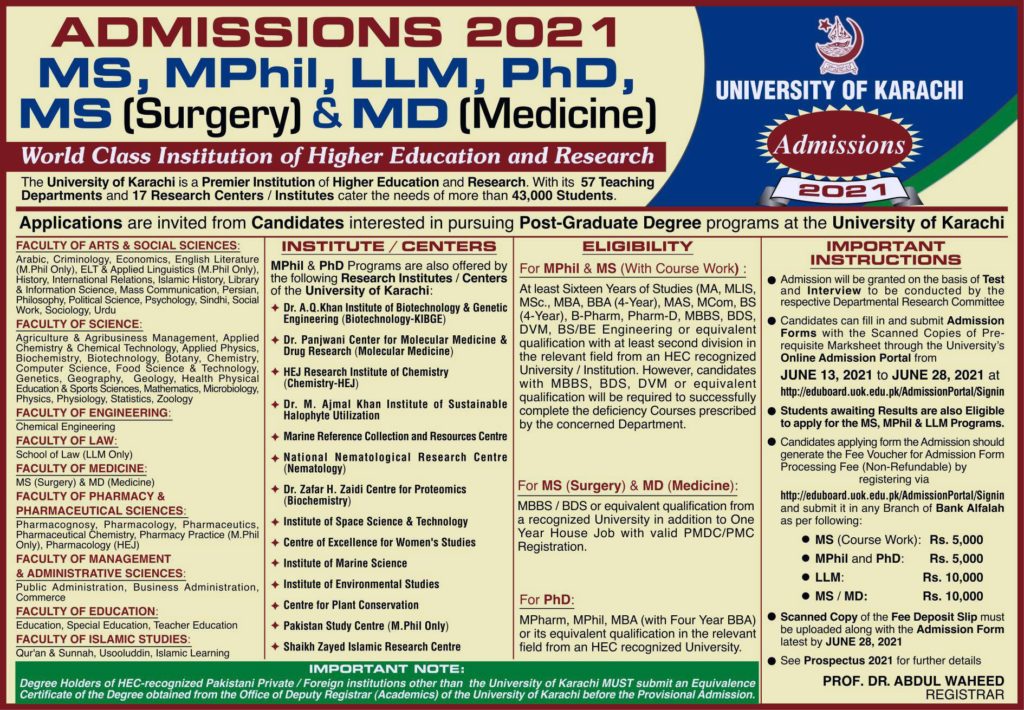University Of Karachi Admission Merit Lists 2023
University Of Karachi Admission information 2021

Karachi University is a public research university located in Karachi, Sindh Province, Pakistan. The university establishes through the rise of the nation and the subsequent development of Jamshoro Sindh University, which establishes in 1951 as a “Federal University” and was designed by Mohsin Baig as its chief architect.
Karachi University has a total of 41,000 full-time students and a campus area of more than 1,200 acres. It is one of the largest universities in Pakistan and enjoys a high reputation for multidisciplinary research in science, technology, medicine, and social sciences. The university has more than 53 departments and 19 research institutions, with 9 colleges under it. There are more than 893 scholars and more than 2500 support staff working for the university.
In 2008, the school rates as one of the world’s top 600 universities by THE-QS World University Rankings for the first time. In 2009, the university ranks as one of the top 500 universities in the world by the now-defunct THE-QS World University Rankings. So In 2016, it rankes among the top 250 in Asia and 701 in the world by the QS World University Rankings. In 2019, it rankes 801 in the world, Asia Ranked 251st. The university is a member of the Association of British Commonwealth Universities.
History
When Pakistan established a sovereign state in 1947, the country’s higher education and research methods were insignificant and dwindling. In response to the imminent demand for higher education, the Pakistani government began to establish higher education and research education institutions and carried out rapid modernization under the guidance of Prime Minister Liakat Ali Khan. Its first principal was Dr. ABA Haleem. In 1953, it began teaching and research activities in two colleges: the Faculty of Arts and the Faculty of Science.
In the first two years, Karachi University remained an examination university for affiliated colleges. Over the years, the scale of enrollment has expanded rapidly. Karachi University initially enrolled 50 students. The university now has 53 academic departments and 20 research centers and research institutes, including the Faculty of Social Sciences, the Faculty of Science, the Faculty of Islamic Studies, the Faculty of Engineering, the Faculty of Law, the Faculty of Pharmacy, the Faculty of Management and School of Administration and School of Medicine. So The number of ordinary students on campus is approximately 28,000. There are more than 1,000 faculty members and more than 3,000 assistants.
Campus
The university campus covers an area of more than 1,279 acres (5.18 square kilometers) and is 12 kilometers away from the Karachi city center. Approximately 4% of the university’s international students come from 23 different countries in Central Asia, South Asia, the Middle East (West Asia), and Europe. Therefore the school’s teaching level high, and the professors mostly internationally renowned scholars and scholars. In just 40 years, this university has achieved a high status in education in Pakistan and the region.
Academic emphasis
The university’s most prestigious research center is the International Center for Chemistry. And Biological Sciences, with more than 500 doctoral students in the fields of organic chemistry, biochemistry, molecular medicine, genomics, and nanotechnology. Husein Ebrahim Jamal Institute of Chemistry, Panjwani Ph.D. Center for Molecular Medicine and Drug Development, and Jamil-ur-Rahman Genome Research Center are integral parts of this multidisciplinary research center. It selects as the UNESCO Center of Excellence in 2016. So the physics and statistics department of the university said to a famous department. And its research results play a vital role in the development of national science and technology.
Library System
The library of Karachi University, known as the “Dr. Mahmoud Hussein Library”, has more than 400,000 books dating back to the 1600s. And used by researchers, advanced students, and faculty. The library became the depository of the personal collection of Pakistani founder Muhammad Ali Jinnah (Muhammad Ali Jinnah). So The Dr. Mahmud Hussain Library, built-in 1952, a magnificent five-story basement structure firmly placed in the center of campus activities. Teachers from more than 100 affiliated colleges and scholars from 19 research institutions frequent the university. There is a loan and resource-sharing system with other academic entities in the Karachi area.
Digital libraries enable scholars and students to access online books. And journals. librarians, 10 assistant librarians, and approximately 90 non-professional staff help maintain the library. So the building includes six general reading rooms and six research rooms. But there is the Latif Ebrahim Jamal Science Information Center in the International Chemical. And Biological Science Center, which is the national focal point for distance education,
University Of Karachi Admission Merit Lists 2023
Originally known as the Karachi University Library, on April 12, 1976, the first anniversary of the death of Professor Mahmoud Hussein Khan, the Karachi University Association unanimously passed a resolution to change its name to the Dr. Mahmoud Hussein Library. So Mahmud Hussain served as the vice-chancellor of the university from 1971 to 1975. Therefore the library was named in recognition of his contribution to the teaching of social sciences in Pakistan. But Dr. Hussein was the first professor appointed by the University of International Relations and History. But He introduced library science to Pakistan by establishing the School of Journalism and Library Science at the university. He is also actively working to improve the status and salaries of library staff so that they are on par with other faculty and staff in the university. The photo shows that UoK is still severely underfunded.

